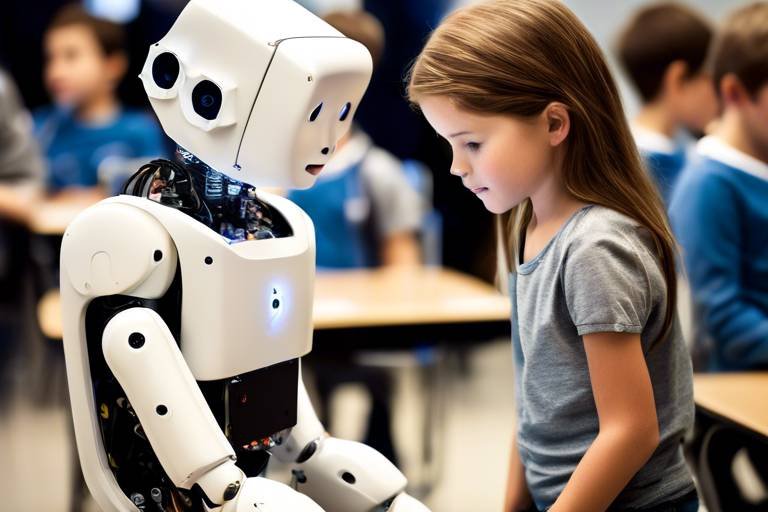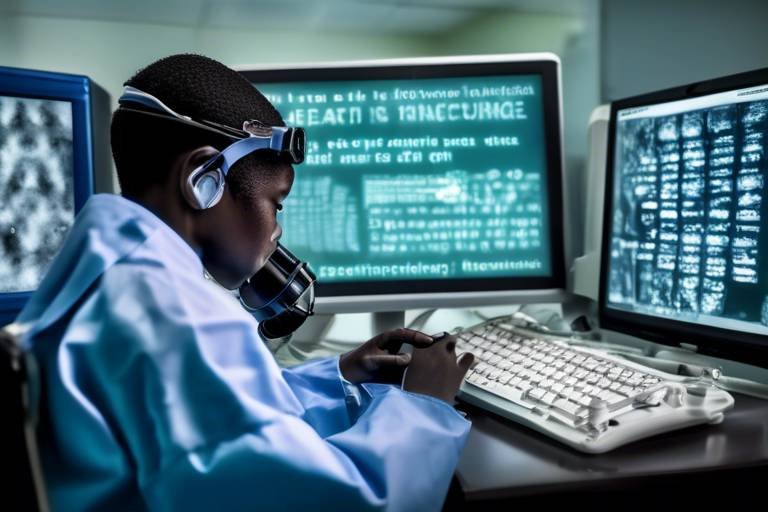How Robotics is Changing the Future of Education
In today’s fast-paced world, robotics is not just a concept from science fiction; it is a reality that is dramatically reshaping the educational landscape. Imagine walking into a classroom where students are not just passive recipients of information but active participants in their learning journey. Robotics is making this possible by introducing innovative teaching methods that engage students through hands-on experiences. By integrating robotics into curricula, educators are not only enhancing student interest in STEM (Science, Technology, Engineering, and Mathematics) fields but also preparing them for a future where technology plays a pivotal role in every aspect of life. So, how exactly is robotics transforming education? Let’s dive in!
The integration of robotics in education is like adding a splash of color to a black-and-white painting. It brings vibrancy and excitement to learning, making complex concepts more accessible and enjoyable. Robotics allows students to engage with technology in a way that is both interactive and practical. By manipulating robots, students not only learn programming and engineering principles but also develop critical thinking skills. This section will explore the significance of incorporating robotics into educational curricula and how it can ignite a passion for learning among students.
When robotics enters the classroom, it brings a treasure trove of benefits that can enhance the educational experience. One of the most significant advantages is the increased student engagement. Robotics projects are inherently exciting and often encourage students to participate actively. Rather than sitting through a lecture, they can build, code, and create, making learning a dynamic experience. Additionally, robotics fosters problem-solving skills as students are challenged to think critically and creatively. They learn to approach problems from different angles and devise innovative solutions. Furthermore, robotics encourages collaboration among peers. Working in teams on robotics projects not only develops interpersonal skills but also prepares students for future collaborative environments.
Robotics challenges students to step outside their comfort zones and engage in critical thinking. When faced with a robotics project, students must devise solutions and work through complex tasks collaboratively. This hands-on approach to learning fosters a deep understanding of problem-solving techniques. For instance, consider a group of students tasked with programming a robot to navigate a maze. They must analyze the problem, brainstorm solutions, and test their code, learning from failures along the way. This iterative process mirrors real-world problem-solving, making it an invaluable educational experience.
Engaging with robotics allows students to explore real-world applications of technology. Through various projects, they can connect classroom learning with practical scenarios, enhancing their understanding of robotics in everyday life. For example, students might design robots that can assist in household chores or help in medical settings. These projects not only solidify their technical skills but also spark creativity as they envision how robotics can improve daily life.
Robotics projects often require teamwork, promoting collaboration among students. Working in groups on robotics tasks helps develop essential interpersonal skills. Students learn to communicate effectively, delegate tasks, and support each other in achieving common goals. This collaborative environment mimics the dynamics of the modern workplace, preparing students for future careers where teamwork is crucial. As they navigate challenges together, they build trust and learn the importance of diverse perspectives in problem-solving.
One of the most remarkable aspects of robotics in education is its potential to improve accessibility for students with disabilities. Adaptive technologies and robotics tools can facilitate inclusive learning environments, ensuring that all students can participate fully in educational activities. For instance, robots can be programmed to assist students with mobility challenges, allowing them to engage more actively in classroom activities. This section will explore various adaptive technologies that are making education more inclusive and accessible for every learner.
As technology continues to evolve, robotics education equips students with essential skills for future careers. The demand for professionals with technical know-how is skyrocketing, and robotics education lays the groundwork for students to thrive in this landscape. By engaging with robotics, students gain experience in programming, engineering, and technology, which are increasingly important in various job markets. This section will discuss how robotics fosters technical skills and prepares students for the demands of the modern workforce.
Robotics education opens pathways to various STEM careers, from engineering to programming. Early exposure to robotics can significantly influence students' career trajectories, guiding them toward future job opportunities in technology-related fields. By participating in robotics programs, students develop a strong foundation in critical technical skills that are highly sought after in the job market.
Beyond technical knowledge, robotics education also cultivates essential soft skills. Skills such as teamwork, communication, and adaptability are developed through robotics projects, preparing students for diverse career environments. In a world where collaboration is key, these soft skills can set students apart and help them succeed in their future endeavors.
- How can robotics enhance student engagement?
Robotics engages students by providing hands-on learning experiences that are interactive and exciting, making them active participants in their education. - What skills do students gain from robotics education?
Students develop both technical skills, such as programming and engineering, and soft skills, including teamwork and communication. - How does robotics improve accessibility in education?
Robotics can provide adaptive technologies that help students with disabilities participate fully in classroom activities. - What career opportunities are available in the field of robotics?
Career pathways include engineering, programming, robotics design, and various roles in technology-related industries.

Introduction to Robotics in Education
Imagine walking into a classroom where students are not just passively absorbing information but actively engaging with technology that brings learning to life. Robotics in education is revolutionizing traditional teaching methods by introducing innovative approaches that captivate students' attention and spark their curiosity. It’s like transforming a dull, static painting into a vibrant, interactive mural where every brushstroke tells a story. By integrating robotics into the curriculum, educators can create a dynamic learning environment that enhances student interest, particularly in the fields of Science, Technology, Engineering, and Mathematics (STEM).
Robotics fosters a hands-on learning experience that allows students to explore complex concepts in a tangible way. For instance, when students build and program their own robots, they’re not just learning about mechanics and electronics; they’re also developing critical thinking and problem-solving skills along the way. This interactive approach encourages students to ask questions, experiment, and learn from their failures, much like a scientist in a lab. The significance of integrating robotics into education cannot be overstated, as it not only prepares students for future careers but also ignites a passion for learning that can last a lifetime.
Furthermore, as we delve deeper into the world of robotics, we find that it serves as a bridge to connect students with real-world applications of technology. Imagine students designing robots that can perform tasks like sorting waste, assisting in healthcare, or even exploring distant planets. This not only enhances their understanding of robotics but also demonstrates how technology can solve real-life problems. As we explore the various benefits of robotics in education, it becomes clear that this field is not just about machines; it's about shaping the minds of future innovators and leaders.
In summary, the integration of robotics in education is not merely an enhancement; it is a transformation that redefines how students learn and interact with the world around them. By embracing this technology, educators can cultivate a generation of learners who are not only knowledgeable but also equipped with the skills necessary to thrive in an increasingly automated future.

Benefits of Robotics in the Classroom
The incorporation of robotics in classrooms is not just a trend; it’s a revolutionary approach that brings a plethora of benefits to students and educators alike. Imagine walking into a classroom where students are not just passive recipients of information, but active participants in their learning journey. Robotics fosters this dynamic environment, making learning not only engaging but also effective. By integrating robotics into the curriculum, educators can create a stimulating atmosphere that sparks curiosity and encourages exploration.
One of the most significant advantages of robotics in education is the increase in student engagement. Traditional teaching methods often struggle to capture the attention of students, especially in a world filled with distractions. Robotics, however, captivates students’ imaginations. When they are tasked with building and programming robots, they become invested in the learning process. This hands-on experience allows them to see the immediate results of their efforts, making learning tangible and exciting.
Additionally, robotics enhances problem-solving skills. Students are presented with challenges that require critical thinking and creativity. For instance, when faced with a task to program a robot to navigate a maze, students must analyze the problem, devise a strategy, and implement their solutions. This process not only sharpens their analytical skills but also teaches them how to approach complex tasks methodically. Such experiences are invaluable as they prepare students for real-world challenges.
Furthermore, robotics promotes collaboration and teamwork. Many robotics projects require students to work in groups, fostering an environment where they learn to communicate effectively and share ideas. This collaborative aspect mirrors modern workplaces, where teamwork is essential. As students brainstorm, troubleshoot, and celebrate their successes together, they develop interpersonal skills that will serve them well in their future careers.
In addition to enhancing engagement and collaboration, robotics also provides a unique opportunity for students to explore real-world applications of technology. By connecting classroom learning with practical scenarios, students gain a deeper understanding of how robotics impacts everyday life. For example, projects that involve designing robots for specific tasks—like sorting recyclables or assisting in healthcare—help students appreciate the relevance of their studies. This connection to the real world not only makes learning more meaningful but also inspires students to consider careers in STEM fields.
As we consider the multifaceted benefits of robotics in the classroom, it becomes clear that this technology is not just a tool for learning; it is a catalyst for a more engaging, collaborative, and practical educational experience. By embracing robotics, educators can equip students with the skills and mindset needed to thrive in an increasingly automated world.
- What age group can benefit from robotics in education?
Robotics can be introduced to students as young as elementary school, with programs tailored to different age groups to ensure appropriate complexity and engagement. - Do students need prior experience with technology to engage in robotics?
No prior experience is necessary. Robotics programs are designed to accommodate beginners and gradually introduce more complex concepts. - How can schools implement robotics programs?
Schools can start by incorporating robotics kits into their curriculum, partnering with local organizations, or even hosting robotics clubs to encourage student participation.

Enhancing Problem-Solving Skills
In today's rapidly evolving educational landscape, problem-solving skills are more crucial than ever. Robotics education serves as a dynamic platform for students to hone these essential skills. Imagine a classroom buzzing with excitement, where students are not just passive recipients of knowledge but active participants in their learning journey. By engaging in robotics projects, students are faced with real challenges that require them to think critically and creatively. This hands-on approach not only makes learning enjoyable but also cultivates an environment where problem-solving becomes second nature.
One of the most fascinating aspects of robotics is how it encourages students to tackle complex problems collaboratively. For instance, when students work in teams to design and program a robot, they must communicate effectively, share ideas, and brainstorm solutions together. This collaborative effort mirrors real-world scenarios, where teamwork is often key to overcoming obstacles. As they navigate through challenges, students learn to break down problems into manageable parts, analyze potential solutions, and implement their ideas in a structured manner.
Consider a scenario where a group of students is tasked with building a robot that can navigate through an obstacle course. They must first identify the obstacles, understand the mechanics of movement, and devise a strategy to overcome each challenge. This process involves:
- Identifying the problem: What are the obstacles?
- Researching solutions: What technologies can help?
- Testing and iterating: What works and what doesn’t?
- Collaborating: How can we combine our strengths?
Through these steps, students not only learn about robotics but also develop a methodical approach to problem-solving that they can apply in various contexts, both inside and outside the classroom. The iterative process of testing and refining their designs teaches them resilience and adaptability—qualities that are invaluable in any career.
Furthermore, the integration of robotics into education allows students to experience failure in a safe environment. When a robot doesn’t perform as expected, it’s not just a setback; it’s an opportunity to analyze what went wrong and to learn from it. This aspect of robotics education fosters a growth mindset, encouraging students to view challenges as stepping stones rather than roadblocks. By embracing failure, students become more confident in their ability to tackle future problems, enhancing their overall problem-solving capabilities.
In summary, robotics education is a powerful tool for enhancing problem-solving skills among students. By engaging in hands-on projects, collaborating with peers, and learning from failures, students not only acquire technical knowledge but also develop critical thinking skills that will serve them well throughout their lives. As we continue to integrate robotics into educational curricula, we are not just teaching students about technology; we are preparing them to become the innovative problem solvers of tomorrow.
Q: How does robotics education improve problem-solving skills?
A: Robotics education engages students in hands-on projects that require critical thinking, collaboration, and iterative testing, all of which enhance their problem-solving abilities.
Q: Can robotics help students who struggle with traditional learning methods?
A: Yes! Robotics provides an interactive and engaging way for students to learn, making it particularly beneficial for those who may struggle with conventional teaching methods.
Q: What age groups can benefit from robotics education?
A: Robotics education can be tailored for various age groups, from elementary school students to high schoolers, making it accessible and beneficial for all levels of learning.

Real-World Applications
When it comes to robotics in education, one of the most exciting aspects is how it bridges the gap between theoretical knowledge and real-world applications. Imagine a classroom buzzing with the sounds of gears turning and sensors beeping, where students are not just passive recipients of information, but active creators of technology. This hands-on approach allows students to see the relevance of their studies in a practical context, turning abstract concepts into tangible experiences.
For instance, students can participate in projects that involve building and programming robots to solve specific problems. These projects often mimic real-life scenarios, such as designing a robot that can navigate through a maze or even create a robotic arm that can assist in assembly line tasks. By tackling these challenges, students not only learn about robotics but also gain insights into how technology is applied in various industries.
Moreover, the integration of robotics in education fosters creativity and innovation. Students are encouraged to think outside the box, experimenting with different designs and programming techniques. This experimentation is akin to being a scientist in a lab, where trial and error lead to breakthroughs. For example, a project might involve developing a robot that can assist in environmental conservation by monitoring pollution levels in water bodies. Such projects not only enhance students' problem-solving skills but also instill a sense of responsibility towards societal issues.
To illustrate the diverse applications of robotics in education, consider the following table:
| Project Type | Description | Skills Developed |
|---|---|---|
| Robotic Competitions | Students design robots to compete in various challenges. | Engineering, Teamwork, Critical Thinking |
| Community Service Robots | Developing robots that assist in community services, like waste management. | Social Responsibility, Programming, Design Thinking |
| Research Projects | Students investigate real-world problems using robotics, such as disaster response. | Analytical Skills, Research Methodology, Collaboration |
These projects not only provide a platform for students to apply their knowledge but also inspire them to pursue careers in fields like engineering, environmental science, and technology. The real-world applications of robotics in education are not just about learning how to build a machine; they are about understanding the impact of technology on society and preparing students to be innovators in their own right.
In conclusion, the incorporation of robotics into educational curricula is a game-changer. It transforms the learning experience from a passive absorption of facts to an active engagement with technology. By working on real-world applications, students develop a deeper understanding of the subject matter and its implications, preparing them for a future where they can contribute meaningfully to society.
- What age group can benefit from robotics education? Robotics education can be tailored for all age groups, from elementary school students to high schoolers, and even adults in continuing education programs.
- Do students need prior experience to start learning robotics? No prior experience is necessary! Most robotics programs are designed to accommodate beginners and gradually introduce more complex concepts.
- How can robotics improve critical thinking skills? Robotics challenges students to design, troubleshoot, and optimize their creations, fostering critical thinking and problem-solving abilities.
- Are there any online resources for learning robotics? Yes! There are numerous online platforms offering courses, tutorials, and community support for aspiring robotics enthusiasts.

Collaboration and Teamwork
When it comes to learning, the age-old saying "two heads are better than one" rings especially true in the context of robotics education. are not just buzzwords; they are essential components of the robotics experience that can transform how students interact with each other and the material they are learning. Imagine a group of students huddled around a robot, each one contributing their unique perspective and skill set to solve a complex problem. This dynamic environment fosters a sense of community and encourages students to rely on one another, which is a crucial skill in today's interconnected world.
In robotics projects, students often take on different roles that play to their strengths. For example, one student might excel in coding, while another might have a knack for design. By dividing tasks based on individual skill sets, students learn to appreciate the value of each team member's contribution. This not only enhances the project's outcome but also builds a sense of accountability. After all, when a robot fails to perform as expected, it’s not just one person’s responsibility; it’s a collective challenge that everyone must tackle together.
Moreover, working in teams on robotics projects cultivates essential interpersonal skills. Students learn how to communicate effectively, negotiate ideas, and resolve conflicts. These experiences mimic real-world situations where teamwork is necessary. For instance, in a corporate setting, employees often need to collaborate on projects, share feedback, and brainstorm solutions. By engaging in robotics education, students are essentially preparing themselves for these future scenarios.
To further illustrate the importance of collaboration in robotics, consider the following key benefits:
- Enhanced Creativity: When students collaborate, they can brainstorm innovative ideas that might not surface in isolation.
- Conflict Resolution: Working through disagreements teaches students how to handle conflicts professionally.
- Shared Learning: Team members can learn from each other's strengths and weaknesses, enriching their educational experience.
In essence, robotics education is more than just building and programming machines; it’s about cultivating a collaborative spirit that students can carry with them into their future careers. They learn that success is often a team effort, and this realization can be a powerful motivator. As they navigate through challenges together, they develop a sense of camaraderie that can last a lifetime. In a world that increasingly values teamwork and collaboration, the skills honed in the robotics classroom will undoubtedly give students a competitive edge.
Q1: How does robotics education improve teamwork skills?
A1: Robotics education encourages students to work in groups, where they must communicate, negotiate roles, and solve problems together, thereby enhancing their teamwork skills.
Q2: What types of projects promote collaboration in robotics?
A2: Projects that require multiple components, such as building a robot from scratch or programming a robot to complete a task, often necessitate collaboration among students with different skill sets.
Q3: Can robotics education benefit students who prefer to work independently?
A3: Yes, even students who prefer independent work can benefit from robotics education, as they learn to appreciate the value of teamwork while still contributing their unique skills to group projects.

Improving Accessibility in Education
In today's diverse educational landscape, accessibility is a crucial factor that cannot be overlooked. Robotics plays a pivotal role in enhancing accessibility for students with disabilities, opening doors to learning experiences that were previously challenging or even impossible. Imagine a classroom where every student, regardless of their physical or cognitive abilities, can engage with the curriculum on equal footing. This is not just a dream; it's a reality made possible through the integration of robotics.
Adaptive technologies, such as robotic assistants and specialized software, have revolutionized the way students with disabilities interact with their learning environments. For instance, consider a student who has mobility challenges. With the help of robotic devices, they can participate in hands-on activities that involve building and programming robots, just like their peers. This not only fosters a sense of inclusion but also boosts their confidence and motivation to learn.
Moreover, robotics can facilitate personalized learning experiences. By using programmable robots that respond to specific commands and inputs, educators can tailor lessons to meet the unique needs of each student. This individualized approach allows for greater engagement and understanding, as students can learn at their own pace and in ways that resonate with them. For example, a visually impaired student can use tactile feedback from a robot to understand spatial relationships, while a student with hearing impairments can engage with visual programming interfaces.
To further illustrate the impact of robotics on accessibility, let's look at some examples of technologies that are making a difference:
- Assistive Robots: These robots can help students with tasks ranging from simple mobility assistance to complex learning activities.
- Interactive Learning Tools: Robotics kits designed for various learning levels can accommodate students with different abilities, ensuring everyone can participate.
- Speech Recognition Software: This technology allows students who may have difficulty with traditional forms of communication to engage with their peers and educators effectively.
By implementing these innovations, educators can create a more inclusive environment that not only accommodates but celebrates diversity. It’s about breaking down barriers and ensuring that every student has the opportunity to thrive in their educational journey. As we move forward, it’s essential to continue exploring and investing in these technologies to enhance accessibility for all students.
In conclusion, the integration of robotics into education is not just about improving learning outcomes; it’s about creating a more equitable educational landscape. By embracing these advancements, we can ensure that every student, regardless of their challenges, has the tools and support they need to succeed.
Q1: How do robots improve accessibility for students with disabilities?
A1: Robots can assist students with disabilities by providing adaptive technologies that cater to their specific needs, enabling them to participate fully in learning activities.
Q2: What types of robotics tools are available for inclusive education?
A2: There are various tools, including assistive robots, interactive learning kits, and speech recognition software, designed to support students with diverse abilities.
Q3: Can robotics help with personalized learning?
A3: Yes, robotics can facilitate personalized learning experiences by allowing educators to tailor lessons to meet the unique needs of each student, promoting engagement and understanding.

Preparing Students for Future Careers
As we navigate through the 21st century, the landscape of employment is shifting dramatically. The integration of robotics in education is not merely a trend; it's a vital component that prepares students for the future workforce. With technology evolving at an unprecedented pace, students equipped with robotics skills will find themselves at a significant advantage in various job markets. Imagine a world where every student has the opportunity to learn not just the basics of coding or robotics, but also how to innovate and solve complex problems—this is the future we are building.
Robotics education fosters a unique blend of technical expertise and creative thinking. Students who engage with robotics learn to program, design, and troubleshoot, developing a toolkit of skills that are highly sought after in today's job market. These skills are not just limited to traditional STEM fields; they are applicable across a multitude of industries, from healthcare to entertainment. For instance, consider how robotics is revolutionizing surgery with precision instruments or how it is enhancing customer experiences in retail through automated systems. The possibilities are endless!
Moreover, robotics education opens up exciting STEM career pathways. By introducing students to the fundamentals of robotics at an early age, we can inspire them to pursue careers in areas such as:
- Engineering
- Software Development
- Data Analysis
- Artificial Intelligence
These fields are not just the future; they are the present! By fostering interest in robotics, educators can guide students toward lucrative and fulfilling careers that will shape the technological landscape of tomorrow.
However, it's not just about technical skills. Robotics education also emphasizes the development of soft skills that are crucial in any career. Skills such as teamwork, communication, and adaptability are fostered through collaborative robotics projects. When students work together to build a robot, they learn to articulate their ideas clearly, listen to others, and adapt their strategies based on group dynamics. This collaborative environment mirrors real-world work situations, where teamwork is often the key to success.
Additionally, educational institutions are increasingly recognizing the importance of integrating robotics into their curricula. Many schools are now offering specialized programs and after-school clubs focused on robotics. These initiatives not only engage students but also prepare them for competitions, such as robotics tournaments, where they can showcase their skills and creativity. The thrill of competition adds an exciting layer to learning, motivating students to push their boundaries and innovate.
In summary, preparing students for future careers through robotics education is a multifaceted approach that encompasses technical training, soft skill development, and real-world applications. As we continue to embrace technology in the classroom, we are not just teaching students how to operate machines; we are empowering them to become the innovators and leaders of tomorrow. The future is bright for those who dare to embrace the world of robotics!
1. Why is robotics education important for students?
Robotics education equips students with essential technical and soft skills, preparing them for a variety of careers in an increasingly automated world.
2. What are some career paths available after studying robotics?
Students can pursue careers in engineering, software development, artificial intelligence, data analysis, and many more fields that require technological expertise.
3. How does robotics education promote teamwork?
Robotics projects often require collaboration, encouraging students to work together, communicate effectively, and develop problem-solving skills in a team setting.
4. Can robotics education benefit students with disabilities?
Yes! Robotics can enhance accessibility and provide inclusive learning environments, allowing all students to engage in educational activities.

STEM Career Pathways
In the rapidly evolving world of technology, robotics education serves as a launchpad for students aspiring to enter various STEM (Science, Technology, Engineering, and Mathematics) career pathways. By engaging with robotics at an early age, students not only develop technical skills but also gain a deeper understanding of how these skills apply to real-world scenarios. Imagine a student who builds a simple robot in class; this experience is not merely about assembling parts, but rather, it’s a gateway to exploring careers in engineering, programming, and even artificial intelligence.
As students immerse themselves in robotics, they are introduced to a multitude of career options that are in high demand in today’s job market. Here are a few notable pathways:
- Robotics Engineer: These professionals design and build robotic systems, often working in industries such as manufacturing, healthcare, and space exploration.
- Software Developer: Many robotics projects require coding and software development, leading students to careers where they can create innovative software solutions.
- Data Scientist: With the rise of AI and machine learning, understanding data is crucial, and students with a background in robotics can easily transition into this field.
- Systems Analyst: This role involves analyzing and improving computer systems, a skill set that is often honed through robotics education.
Furthermore, the integration of robotics in education provides students with a competitive edge. Employers are increasingly looking for candidates who possess not only technical expertise but also the ability to work collaboratively in teams, think critically, and adapt to new challenges. In robotics, students often work on group projects, enhancing their teamwork skills and learning to communicate effectively with peers. This collaborative environment mimics the real-world workplace, preparing them for future roles where teamwork is essential.
Additionally, exposure to robotics can ignite a passion for STEM fields that students may not have considered before. For instance, a student who initially shows interest in art may discover a newfound love for engineering through a robotics project that combines creativity with technical skills. This cross-disciplinary approach to learning is vital in today’s interconnected world, where the boundaries between different fields are increasingly blurred.
As we look to the future, it’s clear that the demand for skilled professionals in STEM fields will only continue to grow. The U.S. Bureau of Labor Statistics projects that employment in STEM occupations will increase significantly over the next decade. By incorporating robotics into educational curricula, we are not just teaching students how to build robots; we are equipping them with the tools they need to succeed in a technology-driven economy.
In conclusion, the pathways opened by robotics education are vast and varied. Whether students aspire to be engineers, software developers, or data scientists, the skills and experiences gained through robotics will serve as a solid foundation for their future careers. As educators and parents, it’s essential to foster this interest and provide opportunities for students to explore the exciting world of robotics, ensuring they are well-prepared for the challenges and opportunities that lie ahead.
Q1: What age is appropriate to start learning robotics?
A1: Students can begin learning robotics as early as elementary school, with age-appropriate kits and programs designed to introduce basic concepts.
Q2: Do I need a strong background in math or science to pursue a career in robotics?
A2: While a background in math and science is beneficial, many robotics programs focus on hands-on learning and problem-solving, making it accessible for all students.
Q3: How can parents encourage their children to explore robotics?
A3: Parents can support their children by providing them with robotics kits, enrolling them in workshops, or encouraging participation in school robotics clubs.

Soft Skills Development
In today's fast-paced world, soft skills have become just as crucial as technical abilities, especially in the realm of robotics education. As students dive into the world of robotics, they are not only learning how to build and program robots but also honing their interpersonal skills in ways that are both profound and transformative. Think about it: when students collaborate on a robotics project, they are thrust into a dynamic environment that requires them to communicate effectively, negotiate roles, and solve problems together. This process mimics real-world scenarios where teamwork and communication are key to success.
For instance, during a robotics competition, students must work as a cohesive unit, each member bringing their unique strengths to the table. This collaborative effort fosters a sense of community and teaches students how to navigate conflicts, share ideas, and celebrate each other's contributions. It's like a well-oiled machine; every part has to work together for the whole to function effectively. By engaging in such projects, students learn to appreciate diverse perspectives, which is invaluable in any career path they choose.
Additionally, robotics education encourages students to develop adaptability. In a field that is constantly evolving, being able to pivot and adjust to new challenges is essential. Whether it's troubleshooting a malfunctioning robot or rethinking a design approach, students learn that flexibility is key. This adaptability not only prepares them for technical challenges but also equips them with the resilience needed to face the uncertainties of the job market.
Moreover, the process of working on robotics projects often leads to the development of leadership skills. Students may find themselves taking charge of specific tasks, guiding their peers, or even mentoring younger students. This hands-on experience builds confidence and instills a sense of responsibility, qualities that are highly sought after by employers. In fact, many organizations today emphasize the importance of leadership abilities alongside technical expertise.
To illustrate the importance of soft skills in robotics education, consider the following table that highlights key soft skills developed through robotics projects:
| Soft Skill | How it is Developed | Real-World Application |
|---|---|---|
| Communication | Students discuss ideas, delegate tasks, and present their projects. | Effective communication in team settings and workplace environments. |
| Teamwork | Collaborating on projects and learning to value each member's input. | Working in diverse teams in various career fields. |
| Problem-Solving | Tackling challenges during the design and build phases. | Addressing complex issues in any professional setting. |
| Adaptability | Adjusting to new information and unexpected challenges. | Thriving in fast-paced and changing work environments. |
| Leadership | Taking initiative and guiding peers in project completion. | Leading teams and projects in professional contexts. |
In conclusion, robotics education is not just about learning to code or build machines; it's a comprehensive approach that cultivates essential soft skills. These skills are the glue that holds technical knowledge together, making students not only proficient in robotics but also well-rounded individuals ready to tackle the challenges of the future.
- What are soft skills? Soft skills are personal attributes that enable someone to interact effectively and harmoniously with other people.
- Why are soft skills important in robotics? They enhance collaboration, communication, and adaptability, which are crucial for success in both educational and professional settings.
- How can students develop soft skills through robotics? By participating in group projects, competitions, and collaborative learning experiences, students can practice and improve their soft skills.
- Are soft skills as important as technical skills? Yes, many employers value soft skills equally or even more than technical skills, as they contribute to a positive work environment and effective teamwork.
Frequently Asked Questions
- What is the role of robotics in education?
Robotics plays a transformative role in education by introducing innovative teaching methods that engage students in hands-on learning experiences. It enhances student interest in STEM fields, making learning more interactive and enjoyable.
- How does robotics improve problem-solving skills?
Engaging with robotics challenges students to think critically and creatively. Through robotics projects, they learn to devise solutions and tackle complex tasks collaboratively, which significantly enhances their problem-solving capabilities.
- Can robotics help students with disabilities?
Absolutely! Robotics can improve accessibility in education by utilizing adaptive technologies and tools that create inclusive learning environments. This ensures that all students, regardless of their abilities, can participate fully in educational activities.
- What are the benefits of teamwork in robotics projects?
Teamwork in robotics projects fosters collaboration among students, helping them develop essential interpersonal skills. Working in groups prepares them for future collaborative environments, which are crucial in both academic and professional settings.
- How does robotics education prepare students for future careers?
Robotics education equips students with technical skills that are essential for various STEM careers, from engineering to programming. It also cultivates soft skills like communication and adaptability, which are vital in diverse career environments.
- What STEM career pathways can robotics lead to?
Robotics opens up numerous pathways in STEM careers. Early exposure to robotics can guide students toward job opportunities in technology-related fields, including engineering, computer science, and robotics programming.
- Are there any specific robotics tools for classroom use?
Yes! There are various robotics tools designed for educational use, such as programmable robots, kits for building robots, and software that allows students to code their robots. These tools make it easier for educators to integrate robotics into their curricula.



















